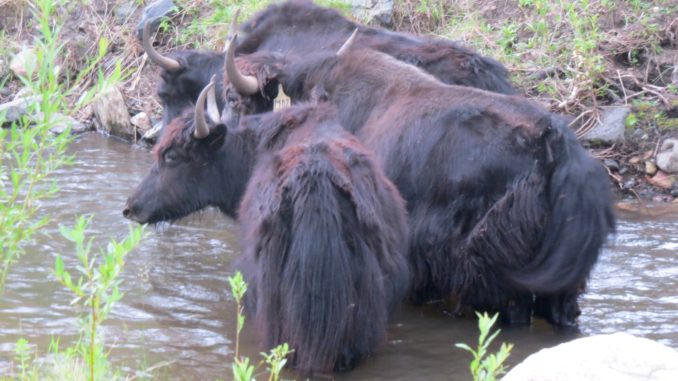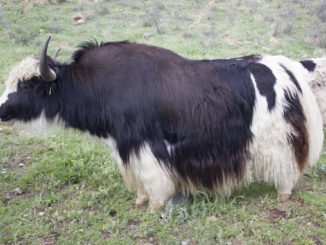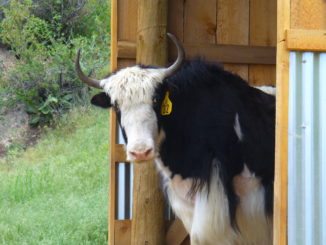
“I had just brought my first five yaks home,” says Terry Clingan of the Buckhorn Canyon in rural Bellvue. “A very exciting day…until the horse suddenly galloped across the pasture to check out the new arrivals. The yaks decided they didn’t want any part of it, and all but the bull charged through the fence.”
Clingan managed to catch two of the four escapees fairly quickly. “My daughter saw the escape firsthand. We drove down the road to search for them and were stopped by someone waving their arms, telling people to slow down because there were yaks in the road. With the help of a passerby and a neighbor, we were able to contain two of them in someone’s pasture.”
As for the other two yaks, both yearling heifers, “They ran up a sheer cliff, and we haven’t seen them since.”
The great escape happened only two hours after the yaks had arrived at Clingan’s ranch, in the summer of 2016. “They didn’t know how to get back, since ‘home’ was not familiar to them yet.”
Clingan put up a sign along the road, in hopes that someone might spot the yaks that were still on the lam. For months, not a word.

Two black yaks are still on the loose.
Meanwhile, his small herd was growing, with the addition of two adult cows and a bull. He says the shaggy, sure-footed animals are “a good fit for the Colorado terrain and climate. They really enjoy the cold, snowy winter.” Eventually, he hopes to sell meat and fiber, as well as calves.
Eight yaks were now in his pasture, but two were still on the loose. Finally, his sign began to produce results, and every now and then he’d get a call. “I’ve heard from about 10 people who have seen them while hiking.” Like the rest of his herd, the two escapees are solid black, and most of the hikers who have spotted them “think they are bears at first.”
Rounding up the wayward yaks is no easy task. They appear to be staying on U.S. Forest Service land, about 10 miles from Clingan’s ranch as the crow flies. Under that soaring crow is extremely rugged, difficult terrain in a remote area, up and down steep mountains to near treeline. A hiker who called to report seeing the yaks told Clingan he hikes Long’s Peak regularly, but to get to the yaks, “he says it’s a tough hike.” The Forest Service, says Clingan, “doesn’t seem concerned about them being there.”
Clingan is able to nearly pinpoint the location, thanks to the latest report he received this week: “They are just east of the northeast border of Rocky Mountain National Park, in the saddle between North and South Signal Mountains, then to the west just above tree line at about 11,000′.” The yaks are apparently about hallway—5 to 6 miles—between two trails, the Dunraven trail that starts near Glen Haven, and another trail near Pingree Park.
“I really don’t know how to go about retrieving them,” says Clingan. “My wife thinks that it would make a good reality TV show—‘The Yak Challenge,’ a competition to see which team can safely capture and return the runaway yaks first.”
“A happy ending would be to walk out and see them in the pasture with the others, but the chances of that happening are pretty much nonexistent,” says Clingan.
He is offering a $500 reward for the capture and safe return of the runaway yaks—which he’s dubbed “Thelma” and “Louise.”
Keep up with the yaks on the Facebook page for Kokopelli Mountain Ranch—the home of Terry Clingan and his wife Raina, who fell in love with the place at first sight. After showing them the property, the realtor told them to “think it over,” and they did—for a short distance down the dirt lane. Then they stopped their car, walked back to the realtor following behind, and said they wanted to make an offer. They thoroughly enjoy ranch life and the beautiful surroundings and note, “There’s never a dull moment!”
<ALL PHOTOS BY MATTHEW BARTMANN>
Support Northern Colorado Journalism
Show your support for North Forty News by helping us produce more content. It's a kind and simple gesture that will help us continue to bring more content to you.
BONUS - Donors get a link in their receipt to sign up for our once-per-week instant text messaging alert. Get your e-copy of North Forty News the moment it is released!
Click to Donate



My yaks know to come when the grain bucket is rattled. It’s an easy way to move them But not good for long distances.